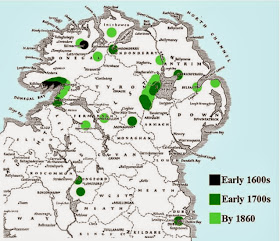A first note: the maps shown in this post are taken from various websites (as attributed in the captions) which allow limited use for personal or professional genealogy use. It is our aim to respect these sources' copyrights and we would ask you not to copy these pictures without understanding and respecting the original allowed uses as well.
So where to start? Our page A Short History of the Vance Surname describes the known and conjectured origins of "Vance" as a last name. While there are a few possible derivations, sources at least agree that "Vance" as a modern surname appeared first in Ulster in Ireland in the 17th century; best documented first in Donegal county in Kilmacrenan and around Donegal town.
Anyone doing Irish research knows that data before 1901 is hard to come by; but from census substitutes and Balbirnie's book in 1860, the VFA can document more than 150 Vance heads of households between the early 1600s and 1860. The growth in Vance families looks like this:
 |
| Earliest spread of the Irish Vances (Source: author) |
But I suspect that the data above under-counts the later Vances in Antrim and Down counties in the east of Ulster, since by the time of Griffith's Valuation (1847-1864) those counties rivaled Donegal in number of Vance families. The Irish Times has a good Vance distribution map from Griffith's Valuation.
The Vance name in the 1800s
By the mid-1800s of course Vance had begun to spread to other countries in the waves of Irish emigration, most notably to the US and Australia. While I don't have early distribution maps for Australia, maps for the 1840 and 1920 US censuses show "Vance" was well-established in the middle Atlantic states and spreading:
 |
| (Source: Ancestry.com) |
 |
| (Source: Ancestry.com) |
Back in the UK. a surname distribution map for the late 1800's shows that "Vance" was centered in it's expected lowland Scotland origins, but had also spread to England as well:
 |
| (Source: www.forebears.co.uk) |
And now into the 1900's, the 1901 Irish census still shows the same patterns as earlier data: a decidedly Ulster bias and a Donegal/Antrim/Down county concentration:
 |
| (Source: www.forebears.co.uk) |
The Vance surname Today
The surname "Vance" around the world today according to 2000-2005 data from the website Public Profiler, is found mainly in the US (182 FPM, or frequency per million people), Australia (61 FPM), Ireland (55 FPM), Canada (40 FPM). the UK (36 FPM), and New Zealand (20 FPM):
 |
| Worldwide distribution of "Vance" today (Source: Public Profiler World Names) |
Within its major countries, here are the surname distributions for 2000-2005:
 |
| North America - distribution of "Vance" today (Source: Public Profiler World Names) |
 |
| UK and Ireland - distribution of "Vance" today (Source: Public Profiler World Names) |
 |
| Australia - distribution of "Vance" today (Source: Public Profiler World Names) |
So what does all this show, apart from the obvious conclusion that there IS such a thing as too many maps? One conclusion is that while the Vance name has grown more numerous in the former British colonies, its distribution in Ireland and Scotland even today still greatly reflects its origins in lowland Scotland and Ulster. In the US, it also seems to indicate that "Vance" has spread slowly south over time although it is still heavily concentrated in areas originally colonized by the Scots-Irish. Of course, this data doesn't distinguish other sources for the "Vance" surname like the known Wentz immigrant families whose surnames were changed to Vance in their new US home.
Data at this "macro" level may not help genealogists who have a good family tree already documented, but it CAN help suggest focus areas for people who don't know where their ancestors emigrated from. Do these maps suggest anything about your research? Or do you have any other distribution maps to add to the set?
